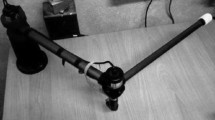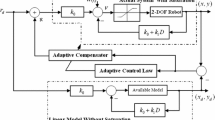Abstract
Impedance control provides a unified solution for the position and force control of robot manipulators. The dynamic behavior of a robotic system in response to environment is prescribed by an impedance model formed as Thevenin model. This model is certain and linear while the robot manipulator is highly nonlinear, coupled, and uncertain. Therefore, impedance control must overcome nonlinearity, coupling, and uncertainty to convert the robotic system to the impedance model. To overcome these problems, this paper presents a novel impedance control for electrically driven robots, which is free from the manipulator dynamics. The novelty of this paper is the use of voltage control strategy to develop the impedance control. Compared with the commonly used impedance control, which is based on the torque control strategy, it is computationally simpler, more efficient, and robust. The mathematical verification and simulation results show the effectiveness of the control method.








Similar content being viewed by others
References
Craig, J.J.: Introduction to Robotics. Addison-Wesley, Reading (1989)
Raibert, M.H., Craig, J.J.: Hybrid position and force control of robot manipulators. J. Dyn. Syst. Meas. Control 102, 126–133 (1981)
Khatib, O.: A unified approach for motion and force control of robot manipulators: the operation-space formulation. IEEE Trans. Robot. Autom. 3(1), 43–53 (1987)
Hogan, N.: Impedance control: an approach to manipulator, Parts I, II, III. J. Dyn. Syst. Meas. Control 3, 1–24 (1985)
Anderson, R., Spong, M.: Hybrid impedance control of robotic manipulators. IEEE Trans. Robot. Autom. 4(5), 549–555 (1988)
Fateh, M.M., Alavi, S.S.: Impedance control of an active suspension system. Mechatronics 19, 134–140 (2009)
Fateh, M.M.: Robust impedance control of a hydraulic suspension system. Int. J. Robust Nonlinear Control 20(8), 858–872 (2010)
Fateh, M.M., Moradi Zirkohi, M.: Adaptive impedance control of a hydraulic suspension system using particle swarm optimization. Veh. Syst. Dyn. 49(12), 1951–1965 (2011)
Akdogan, E., Arif Adli, M.: The design and control of a therapeutic exercise robot for lower limb rehabilitation physiotherabot. Mechatronics 21, 509–522 (2011)
Hogan, N.: On the stability of manipulators performing contact tasks. IEEE J. Robot. Autom. 4, 677–686 (1988)
Colgate, J.E., Hogan, N.: Robust control of dynamically interacting systems. Int. J. Control 48(1), 65–88 (1988)
Krebs, H.I., Hogan, N., Aisen, M.L., Volpe, B.T.: Robot aided neurorehabilitation. IEEE Trans. Rehabil. Eng. 6(1), 75–87 (1998)
Richardson, R., Brown, M., Bhakta, M., Levesley, M.C.: Design and control of a three degree of freedom pneumatic physiotherapy robot. Robotica 21, 589–604 (2003)
Spong, M.W., Hutchinson, S., Vidyasagar, M.: Robot Modelling and Control. Wiley, New York (2006)
Natale, C.: Interaction Control of Robot Manipulators: Six-Degrees-of-Freedom Tasks. Springer Tracts in Advanced Robotics (STAR). Springer, New York (2003)
Zollo, L., Siciliano, B., Luca Guglielmelli, A.D.E., Dario, P.: Compliance control for an anthropomorphic robot with elastic joints: theory and experiments. J. Dyn. Syst. Meas. Control 127(3), 321–328 (2005)
Albu-Schaffer, A., Ott, C., Hirzinger, G.: A unified passivity-based control framework for position, torque and impedance control of flexible joint robots. Int. J. Robot. Res. 26(1), 23–39 (2007)
Ott, C., Albu-Schaffer, A., Kugi, A., Hirzinger, G.: On the passivity based impedance control of flexible joint robots. IEEE Trans. Robot. 24(2), 416–429 (2008)
Colbaugh, R., Seraji, H., Glass, K.: Direct adaptive impedance control of robot manipulators. J. Robot. Syst. 10, 217–248 (1993)
Chien, M.-C., Huang, A.-C.: Adaptive impedance controller design for flexible-joint electrically-driven robots without computation of the regressor matrix. Robotica 30(1), 133–144 (2012)
Kazerooni, H., Sheridan, T.B., Houpt, P.K.: Robust compliant motion for manipulators. Part 1: The fundamental concepts of compliant motion. IEEE J. Robot. Autom. 2(2), 83–92 (1986)
Kazerooni, H., Sheridan, T.B., Houpt, P.K.: Robust compliant motion for manipulators. Part 2: Design method. IEEE J. Robot. Autom. 2(2), 93–105 (1986)
Chan, S.P., Yao, B., Gao, W.B., Cheng, M.: Robust impedance control of robot manipulator. Int. J. Robot. Autom. 6(4), 220–227 (1991)
Jung, S., Hsia, T.C.: Neural network impedance force control of robot manipulator. IEEE Trans. Ind. Electron. 45(3), 451–461 (1998)
Seul, J., Hsia, T.C.: Robust neural force control scheme under uncertainties in robot dynamics and unknown environment. IEEE Trans. Ind. Electron. 47, 403–412 (2000)
Fateh, M.M.: On the voltage-based control of robot manipulators. Int. J. Control. Autom. 6(5), 702–712 (2008)
Fateh, M.M.: Robust fuzzy control of electrical manipulators. J. Intell. Robot. Syst. 60(3–4), 415–434 (2010)
Fateh, M.M.: Robust voltage control of electrical manipulators in task-space. Int. J. Innov. Comput. Inf. Control 6(6), 2691–2700 (2010)
Fateh, M.M.: Robust control of flexible-joint robots using voltage control strategy. Nonlinear Dyn. 67, 1525–1537 (2012)
Fateh, M.M.: Nonlinear control of electrical flexible-joint robots. Nonlinear Dyn. 67(4), 2549–2559 (2011)
Fateh, M.M., Ahsani Tehrani, H., Karbassi, S.M.: Repetitive control of electrically driven robot manipulators. Int. J. Syst. Sci. 44(4), 775–785 (2013)
Fateh, M.M., Khorashadizadeh, S.: Robust control of electrically driven robots by adaptive fuzzy estimation of uncertainty. Nonlinear Dyn. 69(3), 1465–1477 (2012)
Fateh, M.M., Khorashadizadeh, S.: Optimal robust voltage control of electrically driven robot manipulators. Nonlinear Dyn. 70(2), 1445–1458 (2012)
Fateh, M.M., Fateh, S.: Decentralized direct adaptive fuzzy control of robots using voltage control strategy. Nonlinear Dyn. 70(3), 1919–1930 (2012)
Moreno-Valenzuela, J., Campa, R., Santibanez, V.: On passivity-based control of a class of electrically driven robots. In: IECON 2012—38th Annual Conference on IEEE Industrial Electronics Society, pp. 2756–2761 (2012)
Author information
Authors and Affiliations
Corresponding author
Appendix
Appendix
According to the modeling approach given by Spong in [14], the dynamic model of the SCARA robot in Fig. 4 is obtained as
where

In the simulations, the arm which consists of the first three joints is used to perform the proposed impedance control. Thus,

Rights and permissions
About this article
Cite this article
Fateh, M.M., Babaghasabha, R. Impedance control of robots using voltage control strategy. Nonlinear Dyn 74, 277–286 (2013). https://doi.org/10.1007/s11071-013-0964-y
Received:
Accepted:
Published:
Issue Date:
DOI: https://doi.org/10.1007/s11071-013-0964-y




